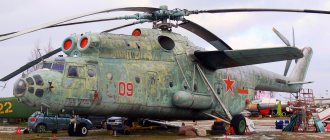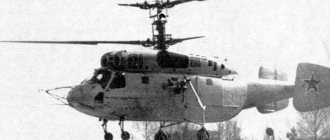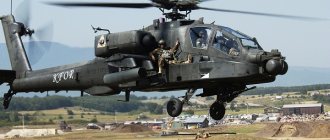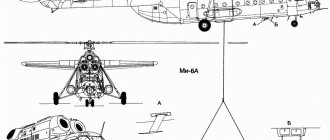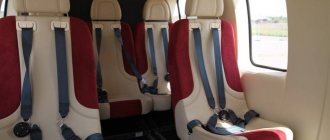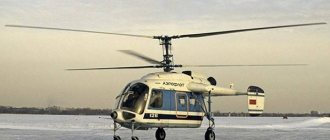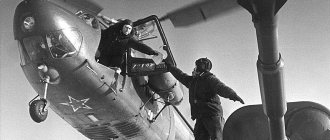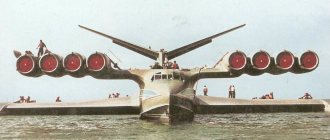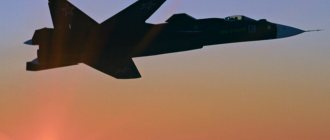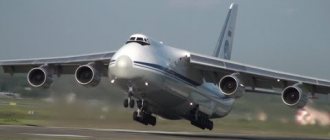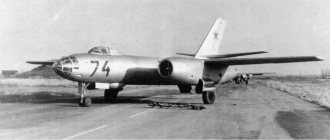| Ka-32 | |
| Helicopter Ka-32S | |
| Type | Transport helicopter |
| OJSC "KumAPP" | |
| First flight | 1980 |
| Start of operation | 1986[1] |
| Units produced | 160+ |
| Basic model | Ka-27 |
| Images on Wikimedia Commons | |
The Ka-32
is a medium coaxial transport helicopter with two turboshaft engines and a fixed landing gear.
The Ka-32 is a civilian development of the search and rescue helicopter Ka-27PS, developed by the Design Bureau named after. N.I. Kamov, taking into account the successful operation of the Ka-25 and Ka-27 family of helicopters from the deck of ships.
Since 1985, Ka-32 helicopters have been mass-produced by KumAPP OJSC. As of 2013, more than 160 Ka-32 helicopters in various modifications were produced.
In 2013, an agreement was concluded with Itong Corporation (China) on the possibility of assembling Ka-32A11BC helicopters in China.[2]
Content
- 1. History
- 2 Flight performance 2.1 Main dimensions
- 2.2 Weight characteristics
- 4.1 Climbing records
- 7.1 In service
Story
The beginning of the development of the Ka-32 helicopter should be taken as for the Ka-27 helicopter, 1969.
Initially, the main purpose of the Ka-32 was intended to be used for reconnaissance of ice conditions in the extreme northern conditions of the Arctic day and night, but later it was decided to develop the helicopter for multi-purpose all-weather use: for search and rescue operations, transport transportation, unloading ships and servicing drilling platforms , crane work during installation of equipment, removal of packages of valuable wood, patrol service and other purposes.
It was decided to equip the helicopter with a sophisticated flight and navigation system with an on-board computer, surveillance radar, anti-icing systems and special equipment. The absence of weapons and anti-submarine search equipment and related systems on the helicopter made it possible to use the internal volumes to accommodate fuel tanks and various equipment for civilian use and ensured an increase in the helicopter's payload capacity.
The first flight of the experimental Ka-32 helicopter took place on December 24, 1973 (test pilot E.I. Laryushin). The first flight of the production Ka-32 helicopter was in 1980.
For the first time in the history of Arctic exploration, at the end of 1978, an experimental Ka-32 helicopter piloted the Sibir nuclear icebreaker with a convoy of ships in polar night conditions.
In 1981, the Ka-32 helicopter was first demonstrated to foreign experts in Minsk at a conference on the use of civil aviation in the national economy, and in 1985 at the Paris Aerospace Exhibition and later at many other exhibitions.
sea soul
Not every helicopter is capable of performing tasks at sea. Of course, we are not talking about flights along the coastline based on ground-based sites, but about the machine being serviced in ship conditions, standing on an open platform (at the stern of the ship) and serving the current requirements for reconnaissance and warning of the naval command. In this case, the technical regulations become seriously complicated; splashes of salt water and severe atmospheric influences can adversely affect the operation of mechanisms, components and assemblies. The Soviet military doctrine of the late forties in terms of possible ocean operations was in a state of development, so Kamov's bureau from the moment of its creation worked in two directions. Firstly, the machines developed here must be suitable for use on aircraft-carrying ships. Secondly, their purpose, due to the uncertainty of future intentions, was assumed to be broad, that is, multi-purpose. These requirements were met by the Ka-8, Ka-15, Ka-25, Ka-26 and especially the Ka-32 - a helicopter most suitable for sailors, firefighters, builders, installers and many other peaceful workers working in the most difficult conditions, in including in humid climates, from polar latitudes to the tropics.
Flight performance
Main Dimensions
- rotor diameter: 15.9 m
- helicopter height: 5.45 m
- helicopter length (with blades folded): 12.217 m
- helicopter width (with blades folded): 3.805 m
- rotor shaft inclination angle: +4°30′ (forward)
The dimensions of the fuselage with the tail do not extend beyond the boundaries of the area swept by the main rotors.
Weight characteristics
- Minimum helicopter take-off weight: 7,200 kg
- Maximum take-off weight of the helicopter: 11,000 kg
- Maximum flight weight with external load: 12,700 kg
- Maximum cargo weight in the cargo compartment:
Ka-32S: 3,300 kg Ka-32T: 3,500 kg Ka-32A and later modifications: 3,700 kg
- Maximum external load weight: 5,000 kg
What can the Ka-32 do?
Aviation experts were surprised by the capabilities that the small Ka-32 has. The characteristics are impressive; with a fuselage length of just over 12 meters, it can easily accommodate cargo weighing over 3.7 tons. When using an external sling, this parameter can be increased to 5 tons. This machine lifts almost as much as driving itself at a vertical speed of 15 m/s. It can deliver cargo to any point within a radius of 900 km. Passenger capacity – 16 people. The speed may seem low to some, “only” 230 cruising and 260 km/h maximum, but the device was not created for racing, and even the initial military anti-submarine version of the Ka-27 was aimed at detecting submarines, which requires a certain leisurely pace . But a ceiling of 6,000 meters ensures safety, even in the event of serious atmospheric problems.
Performance characteristics
Data source: Corner of the Sky
Specifications
- Crew: 2 people
- Passenger capacity: 13 people
- Load capacity: 5000 kg
- Length: 11.30
- Main rotor diameter: 15.90 m
- Height: 5.40 m
- Empty weight: 6000
- Normal take-off weight: 11000 kg
- Powerplant: 2 × TV3-117VMA
- Engine power: 2 × 2200 l. With.
Flight characteristics
- Maximum speed: 260 km/h
- Cruising speed: 240 km/h
- Practical range: 800 km
- Service ceiling: 6000 m
- Static ceiling: 3500 m
World records
The Ka-32 helicopter set several world records registered by the International Aeronautics Federation in the E-1 (Helicopters) subclass. All of them were performed by female crews and belong to women's world records[3].
Climbing records
Time of ascent to a height of 6000 m - 4 minutes 46.5 from May 11, 1983, T. I. Zueva, N. I. Eremina
Time to climb to a height of 3000 m - 2 min 11.1 s May 12, 1983, N. I. Eremina, T. I. Zueva
Maximum flight altitude records
Maximum altitude in horizontal flight - 6552 m (improved in 1985) May 11, 1983, T. I. Zueva, N. I. Eremina
Maximum flight altitude - 8250 m Maximum altitude in horizontal flight - 8215 m January 29, 1985, T. I. Zueva, N. I. Eremina
Lifting records
Lifting height with commercial cargo 1000 kg - 7305 m Lifting height with commercial cargo 2000 kg - 6400 m January 29, 1985, N. I. Eremina, T. I. Zueva
Ka-32 for export
The success of the machine's design is confirmed by the success it enjoys at world air shows, where the Ka-32 helicopter was exhibited and demonstrated. Photos of rotorcraft with South Korean, Canadian, Malaysian or Swiss identification marks do not surprise anyone. A feature of this example of the Soviet and Russian aircraft building school is traditionally reliability, ease of control and ease of training for foreign pilots.
The vehicle has a high modification and modernization potential; the most modern avionics can be installed on it as they become available, which ensures the Ka-32 a long celestial life.
Modifications
Since 2010, only helicopters of the Ka-32A and Ka-32A11BC modifications have been produced. Since 2011, only Ka-32A11BC have been produced.
| Model name | Brief characteristics, differences. |
| Ka-32 | General designation. It most often refers to helicopters of the Ka-32T or Ka-32S modification. Historically, it comes from a time when other modifications did not exist. |
| Ka-32A | Modification of the Ka-32T helicopter in order to fulfill certification requirements. It is a deeper modification compared to the Ka-32AO. The modification differs from the Ka-32AO in the composition of its instrumentation, which ensures flights under IFR day and night; improved total and static pressure system to improve measurement accuracy; as well as lightning protection of radio equipment units. The helicopter has a transport category type certificate and served as the basis for the emergence of new helicopters of the same type. |
| Ka-32A1 | Modification of the Ka-32A helicopter for the Moscow fire service. Developed in 1993. The helicopter is intended for evacuating people and extinguishing fires of varying degrees of complexity, including in high-rise buildings. The helicopter differs from the basic version in additional communications equipment, a specialized fire extinguishing system, and the installation of two spotlights and a loudspeaker for an external warning system. To fight fires, the helicopter is equipped with portable fire extinguishers, aerosol grenades and a horizontal hydraulic cannon. Fire-fighting equipment can be supplemented with a drainage device (a hanging tank with a capacity of up to 5000 liters). To evacuate people from burning buildings, various transport and rescue cabins are used, mounted on an external sling. Parachuteless landing of fire crews while the helicopter is hovering is carried out using descent devices. The helicopter has a characteristic red and white color. |
| Ka-32A2 | Modification of the Ka-32A helicopter for law enforcement agencies. Developed in 1994 in the interests of the Moscow City Internal Affairs Directorate. The helicopter was intended to transport service personnel, search for criminal groups and parachute special forces personnel. The helicopter differs from the basic version in a modified fuel system, additional communications equipment, installation of spotlights and two loudspeakers for an external public address system. The helicopter's fuel system does not have fuel tanks No. 5 (on the sides of the fuselage); the existing fuel tanks are equipped with polyurethane foam filler. The external lighting equipment is supplemented by two spotlights: in the forward part of the fuselage and on a movable truss in the cargo door opening on the left side. Parachuteless landing of special forces personnel while the helicopter is hovering is carried out through the doorway of the transport cabin using descent devices. To allow personnel to use weapons, the helicopter is equipped with pivot mountings for machine guns or machine guns. The helicopter is painted in a spotted camouflage pattern. One helicopter was built. Subsequently, it was converted back into the civilian Ka-32A. |
| Ka-32A4 | Modification of the Ka-32S helicopter for the Armed Forces of the Republic of Korea. Korean designation for the HH-32A . The helicopter is additionally equipped with a weather radar, an on-board computer with an MFI, a searchlight, short-range navigation and landing systems VOR/ILS, and foreign radio stations[4]. The helicopter was developed at KumAPP OJSC together with Israeli companies. |
| Ka-32A6 | Project of a passenger helicopter based on the Ka-32A. The project was distinguished by an enlarged fuselage (transport cabin), adapted for the transport of passengers. No helicopters were built for this project. |
| Ka-32A11BC | Modification of the Ka-32A helicopter based on the results of certification in Canada in 1998. Hence the letters “BC” in the designation of the modification - from British Columbia.[5] The helicopter is distinguished by a two-chamber steering system (power steering unit of the control system), an updated composition of equipment and color marking of instruments in accordance with the requirements of foreign standards. The helicopter is produced in two main versions of instrumentation: with analog instruments in the cockpit and with MFI. Until 2011, the modification of the helicopter was distinguished by increased resources and service life of the main components. The helicopter is actively used for transporting cargo on an external sling, including for hauling wood, construction and installation work and fire fighting. It is possible to install various optional equipment of Russian and foreign production. Until 2011, the helicopter was supplied only for export. The helicopter of this modification is certified in Australia, Brazil, Europe, Canada, China, South Korea and Japan. |
| Ka-32A12 | Execution of the Ka-32A11BC helicopter for Switzerland. Until 2011, the helicopter was considered an independent model, created on the basis of the Ka-32A11BC. Since 2011, the Ka-32A12 has been considered as a modification (separate version) of the Ka-32A11BC and is included in the same type certificate. The modification is distinguished by a modified composition of instrumentation, developed jointly with the operator Heliswiss. 3 helicopters were produced. The helicopters have the operator's red and white signature color scheme. |
| Ka-32AM | Designation of the Ka-32A helicopter project with a payload capacity increased to 7000 kg. |
| Ka-32AO | Early model designation: Ka-32A-O . Ka-32A0 is often encountered . Modification of the Ka-32T helicopter in order to fulfill certification requirements. The helicopter is equipped with certified main engines TV3-117VMA (TV3-117VMA series 02). Additionally installed: an air traffic control transponder and a heat-resistant shockproof tape recorder. Protection made of titanium sheets is installed under the main and auxiliary engines. The helicopter's electrical systems are divided into starboard and port systems. The external suspension system is additionally equipped with an emergency release mechanism. The instrument dials in the cockpit are color coded. The helicopter is certified by the IAC AR and has a limited category type certificate for the transportation of cargo, subject to visual flights during the day. The letter “O” in the helicopter designation comes from the category designation. |
| Ka-32K | The helicopter is a specialized version of the Ka-32T for performing complex construction and installation work (“flying crane”). This modification is distinguished by an additional semi-retractable operator's cabin located at the rear of the fuselage. The helicopter is equipped with a fundamentally new fly-by-wire control system (EDCS), which allows piloting from both the main pilot cabin and the additional operator cabin. There is an automatic system for damping vibrations of a cable with a load on an external sling and a system for automatically maintaining a constant angle of a tensioned cable connected to a load located on the ground. To monitor the cargo, the helicopter is equipped with a television system, which consists of two television cameras: a movable one in the longitudinal plane, installed under the tail, and a fixed one, placed vertically inside the fuselage near the external suspension cable. Both cameras have adjustable apertures and focal lengths. There are two television screens in the pilot's cabin: at the helicopter commander's and at the co-pilot's. Each television screen can display images from any of the cameras. One prototype of a helicopter of this modification was built. The first flight took place on December 28, 1991. The helicopter was first shown at the aerospace exhibition in Berlin in 1992. |
| Ka-32S | Modification of the helicopter for use on ships for ice reconnaissance and search and rescue operations, transportation of cargo on an external sling, and transportation of passengers. The helicopter can service drilling rigs and platforms on the shelf and unload ships. As a search and rescue helicopter, the helicopter is equipped with additional rescue, sanitary and lighting equipment. The helicopter is of the same type as the Ka-32T. |
| Ka-32SI | Designation of the Ka-32S helicopter, designed to conduct environmental studies of water surfaces. The helicopter was equipped with a geological and environmental complex GEVK-1 and a fuel system of increased capacity (with additional tanks No. 7). In 1993, one Ka-32C RA-31584 helicopter (serial number 8706) was equipped. Subsequently, due to the closure of the program, the geological-ecological complex was dismantled from the helicopter. The helicopter was given the designation Ka-32S. |
| Ka-32T | Transport modification of the helicopter for transporting large cargo on an external sling, transporting people and cargo in the transport cabin. It differs from the Ka-32S in the absence of the Octopus locator and its fairing in the nose. Also, search and rescue equipment is not installed on the helicopter. The helicopter is of the same type as the Ka-32S. |
| Ka-32T/S | Universal designation for Ka-32T and Ka-32S helicopters of the same type. |
- Ka-32A
- Ka-32A1
- Ka-32A11BC
- Ka-32A12
- Ka-32K
- Ka-32T
Design of the Ka-32
A twin-rotor coaxial helicopter with two gas turbine engines and a four-legged landing gear. The semi-monocoque fuselage is made of aluminum alloys. The crew cabin is double, located in the bow. The cargo compartment is separated from the cockpit by a partition and has 16 folding seats along the sides. Entrances to the cabins are made in this way: to the crew on both sides, and to the cargo compartment on the left side through a sliding door. To secure various, but small-sized cargo, mooring units are installed in the cabin. The external suspension is mounted into a truss in the cargo compartment. Has a weighing device.
A rectangular stabilizer with two keel washers installed represents the tail unit. Large steering directions are installed on the washers - provides directional stability. The design of the washers and stabilizer is framed, made of composite materials and aluminum alloy.
The four-wheel landing gear cannot be retracted. Presented in the shape of a pyramid with two-chamber oil-air shock absorbers with low and high pressure. Self-orienting front supports are under a pressure of 0.58 MPa. Main support – 1.08 MPa. Some models are modified with installed skis or emergency inflatable balloons.
Three-bladed coaxial propellers hinge the blades to the helicopter (they can fold). The blades are modified according to the NACA 230 profile, presented in the shape of a rectangle. The spars are made of CM fiberglass base, which are reinforced with carbon fibers. The blades are equipped with adjustable trimmers. And thanks to titanium bushings, vibration and vibration levels are kept to a minimum at different speeds.
The power plant is represented by two gas turbine engines with a TVZ-117 turbine and an automatic engine control system. Control of modes and general operation of engines is carried out by a mode indicator on the instrument panel. In the event of a failure, starting is carried out automatically thanks to an auxiliary installation. The main gearbox is two-stage, planetary type, with two freewheels. Equipped with a main rotor brake and a cooling system.
The Ka32 is a coaxial medium transport helicopter with two turboshaft engines and a fixed landing gear.
The Ka-32 is a civilian development of the Ka-27PS rescue search helicopter, which was developed by the Design Bureau named after. Kamova N.I., taking into account the successful operation of the Ka-25 and Ka-27 family of helicopters from the deck of ships.
Helicopter Ka-32 photo.
Since 1985, Ka32 helicopters have been mass-produced by KumAPP OJSC. As of 2013, more than 160 Ka32 helicopters in various modifications were produced.
Ka-32 helicopter photo cabin.
In 2013, an agreement was concluded with the Chinese corporation Itun on the possibility of installing Ka32A11BC helicopters in China.
Aircraft accidents
- June 4, 1987 Ka-32T Murmansk region, Kola district, near the village. Teriberka, 4 people died. The reason was a break in the load on the external sling, as a result of which the broken cable cut off the stabilizer and wound around the rotors.[6]
- August 17, 1990 Ka-32S Murmansk region, 6 km west of Lovozero, 11 people died. The reason is gearbox failure.[7]
- On March 27, 1991, a Ka-32S crashed in the Leningrad region. The reason is the destruction of the lower rotor blade.[8]
- On May 15, 1991, a Ka-32T crashed into the sea in the Primorsky Territory.[9]
- On October 7, 1992, a Ka-32S crashed in the Krasnoyarsk Territory, killing 4 people.[10]
- On June 11, 1999, a Ka-32S crashed in Indonesia, killing 1 person. The reason is a drop in rotor speed.[11]
- On September 4, 2003, a Ka-32 crashed in the Krasnodar region, killing 9 people.[12]
- April 2004 Ka-32 crashed in Malaysia, 1 killed, 2 injured.[13]
- On September 4, 2005, a Ka-32 crashed in Malaysia, killing three.
- On October 23, 2005, a Ka-32 crashed in Azerbaijan, completely burned out, and killed 5 people.[14]
- On August 28, 2006, the Ka-32 crashed in Turkey.[15]
- On November 6, 2009, a Ka-32A, owned by a South Korean private company, crashed on one of the slopes of Mount Chombonsan (1424 m) due to bad weather conditions. Both pilots were killed. The helicopter was used in the division of the Korea Electric Corporation (KEPCO) engaged in the installation of power transmission towers. On the day of the crash, the helicopter was supposed to be transporting a cargo of wood.[16]
- On November 23, 2009, a Ka-32A, operated by the South Korean Forest Service, crashed during a training flight in Jeollanam-do province. The helicopter pilot and two trainees were killed. The helicopter collided with the surface of Lake Yeonam at an angle of 70 degrees. The investigation team came to the conclusion that the crash occurred while simulating the withdrawal of water from the lake to extinguish a forest fire. The main versions of the crash at the investigation stage were considered to be pilot error or equipment failure.[17]
- On September 26, 2010, a Ka-32C (RA-31584) crashed in the Lunnaya Polyana area, Sochi, Krasnodar Territory. The disaster occurred due to self-shutdown of both engines due to the use of substandard fuel and a manufacturing defect in the speed controller of the free turbine of the right engine. 2 people died, 1 was injured.[18]
- On April 26, 2012, a Ka-32 (ER-KGD) crashed near the village of Ostrov in Romania. The helicopter was flying to Turkey to put out fires. All 5 people on board died.[19]
- On July 26, 2012, due to engine failure, the Ka-32AO (RA-31579) made a rough landing near Sochi, Krasnodar Territory. The helicopter received minor damage and there were no casualties.[20]
- On August 9, 2012, a Ka-32T (RA-31596) crashed at 15:20 (local time) near the village of Karacam in the Mugla province of Turkey. All 5 people on board died[21].
- On September 3, 2012, in the area of the village of Memoria (Portugal), during a firefighting flight, the Ka-32A11BC (CS-HMO) as a result of an engine failure, while taking water, followed by acceleration and descent, got caught by the external sling on the fence and fell. The helicopter received significant damage.[22]
- On August 4, 2013, a Ka-32A11BC (C-JKHL) helicopter made a rough landing near the village of Bella Coola (Canada).[23] The helicopter was damaged. There were no casualties.
- On November 11, 2014, a Ka-32 helicopter of the Ministry of Emergency Situations of the Russian Federation, during a scheduled training flight, made a hard landing near the settlement of Sukhaya Padina, Stavropol Territory. The Ka-32 was damaged and caught fire, four people received various injuries, and later one died in the hospital, the pilot of the aircraft died.[24][25]
- On July 3, 2020, a Ka-32S helicopter belonging to Russia made an emergency landing on water. There were 3 crew members on board. No one was injured.[26][27]
Kamov and his style
On the basis of an experimental aircraft plant, which has the meaningless number 290 to the uninitiated, a design bureau was created in 1948, with the also unimpressive name “No. 5”. There is nothing surprising in all these indices; in the Stalin years, less important enterprises could have been classified, but here, as it turned out much later, they built gyroplanes, aircraft almost forgotten in our days. During the recently ended World War II, the Allied forces already used rotary-wing vehicles and helicopters, not very widely yet, but enough for I.V. Stalin realized the promise of a new type of flying technology. The “father of nations” loved aviation; it was under his constant control. N.I. was assigned to head the bureau. Kamov, who already in 1940 managed to design and build the A-7, a gyroplane.
From the very beginning, the design bureau established its own style, by which Kamov helicopters are easily recognizable today. Their main feature can be considered a coaxial design, in which both rotors rotate counter-rotating, mutually compensating the torque. In this case, a steering propeller is not needed.
Operators
- Russia, Russia
- Republic of Korea Republic of Korea: 63 Ka-32T/S and Ka-32A, of which 9 are in service with the Marine Police and 7 in service with the Air Force as search and rescue helicopters. 31 Ka-32s are operated as firefighting helicopters by the Korean Forest Service. In addition to them, 15 Ka-32s are used by various civilian companies and departments[28].
- Ukraine Ukraine
- Bulgaria Bulgaria
- Azerbaijan Azerbaijan: 6 Ka-32 for the Ministry of Emergency Situations[29]
- Canada Canada
- Spain Spain: 10 Ka-32A11BC firefighting helicopters.[30]
- Portugal Portugal: 6 Ka-32A11BC firefighting helicopters[31]
- Switzerland Switzerland
- Japan Japan: 1 Ka-32A11BC[30]
- Kazakhstan Kazakhstan: 2 Ka-32A11BC purchased for the Ministry of Emergency Situations[32].
- Brazil Brazil
- * DPRK DPRK
In service
- Republic of Korea Republic of Korea: 7 Ka-32A4 helicopters delivered, 32 ordered.[33]
Device
The twin-screw coaxial design, traditional for Kamov models, was also useful for the Ka-32. The helicopter is easy to control; gas turbine engines (two of them) of 2,200 horsepower each were inherited from the “combat past,” as was the hinged system for fastening the blades, which allows them to be folded to reduce windage in the event of a storm and reduce the occupied volume. Three doors ensure that the crew quickly takes their places and eases loading and unloading operations. The chassis consists of four supports on which special cylinders can be attached if necessary to land on the water. The floor of the Ka-32 has mooring devices designed to secure cargo weighing up to four tons inside the cargo compartment. In general, like many vehicles of the Kamov Design Bureau, the design makes it possible to usefully use the entire space behind the pilot’s cabin to the very tail section and below the power plant.
Notes
- Russian helicopters – Gorod.tomsk.ru
- “PEKING DUCK” is ready to eat
- E. I. Ruzhitsky
World records for helicopters. Kazan: Helicopter Publishing House, 2005. ISBN 5-901821-04-1 - Website of OJSC "KumAPP" - Ka-32A4 (inaccessible link)
- Due to the fact that the helicopter model designation uses Latin letters, it is written the same in Russian - Ka-32A11BC
, and in English -
Ka-32A11BC
.
Ka-32A11VS
found is incorrect. - Crash of the Ka-32T of the Leningrad CAA in the Murmansk region (board USSR-31004), June 4, 1987. // AirDisaster.ru - aviation accidents, incidents and air crashes in the USSR...
- Crash of the Ka-32S of the Leningrad Civil Aviation Administration near Lovozero (board USSR-31026), August 17, 1990. // AirDisaster.ru - aviation accidents, incidents and air crashes in the USSR and R...
- Crash of the Ka-32S of the Leningrad Civil Aviation Administration in the Leningrad region (board USSR-31023), March 27, 1991. // AirDisaster.ru - aviation accidents, incidents and air crashes in the USSR...
- Crash of the Ka-32T DV UGA in the seaport of Vladivostok (board USSR-31037), May 15, 1991. // AirDisaster.ru - aviation accidents, incidents and air crashes in the USSR and Russia...
- Crash of the Ka-32S of the Murmansk OJSC in the area of Cape Chelyuskin (board USSR-31016), October 7, 1992. // AirDisaster.ru - aviation accidents, incidents and air crashes in the USSR...
- Ka-32S crash at Vladivostokavia in Indonesia (aircraft RA-31029), June 11, 1999. // AirDisaster.ru - aviation accidents, incidents and air crashes in the USSR and Russia...
- Lenta.ru: In Russia: The second flight recorder of the Ka-32 that crashed on Mount Fisht was found Archived copy dated March 5, 2020 on the Wayback Machine
- Lenta.ru: In the world: A Russian Ka-32 helicopter crashed in Malaysia
- Lenta.ru: b. USSR: Russian KA-32 crashed due to a technical problem
- There were no Russians among the crew members of the Ka-32 that crashed in Antalya | Incidents | RIA Novosti news feed
- (Korean)
- — 해양경찰청 노후헬기도 안심 못한다 (Korean)
- Ka-32S crash RA-31584 09/26/2010 - IAC Investigation Archived copy dated May 16, 2012 on the Wayback Machine
- A helicopter crashed in eastern Romania, killing all five people on board.
- Southern MTU FAVT Ministry of Transport of Russia - Report on an accident with a Ka-32AO helicopter RA-31579
- The crew of the helicopter that crashed in Turkey extinguished forest fires
- MAK - Ka-32A11BC 09/03/2012 Archived copy from December 13, 2012 on the Wayback Machine
- Air accident Ka-32A11BC C-JKHL - Information IAC Archived copy of November 3, 2013 on the Wayback Machine
- Victims of the Ka-32 crash were sent to Moscow for treatment
- Emergency Ministry employee injured in Ka-32 crash died in hospital
- A Russian helicopter operating in Turkey made an emergency landing on water. Retrieved November 24, 2020.
- ntv.ru.
A helicopter carrying Russians crashed into the water in Turkey. NTV. Retrieved November 24, 2020. - South Korea may purchase a new batch of Russian Ka-32 helicopters
- Azerbaijan purchased new helicopters from Russia: Society, August 30, 2010
- ↑ 12
Moves with a proven screw // “Zhukovskie Vesti” - Portugal purchased a batch of firefighting helicopters from Russia
- The Ministry of Emergency Situations of Kazakhstan received two Russian-made helicopters (inaccessible link)
- Seoul will spend a billion dollars on the purchase of Russian helicopters
Description of design
The Ka-62 helicopter is made according to a design uncharacteristic for the Kamov Design Bureau with one main rotor and one tail rotor. The tail rotor is located in the vertical tail (the so-called fenestron). The helicopter has two gas turbine engines and a retractable tricycle landing gear.
Composite materials are actively used in the design of the Ka-62; they make up about 50% of the weight of the entire structure.
The helicopter fuselage has a shape with good aerodynamic characteristics; its skin consists almost entirely of composite materials. In the front part of the fuselage there is a two-seat pilot's cabin, behind it there is a cargo-passenger cabin, above which there is a power plant with a transmission and a main rotor. At the rear of the helicopter there is a tail boom with an empennage and a tail rotor.
The cockpit has a significant glass area and provides excellent visibility for the pilots. The cabin doors open outward and forward.
The middle part of the fuselage is occupied by a cargo-passenger cabin, which has dimensions of 3.3 x 1.75 x 1.3 m, and a large sliding cargo door.
An uncontrolled rectangular stabilizer with end washers is located on the tail boom. The tail rotor is located in a profiled channel located in the tail boom. A vertical keel of an asymmetrical profile is installed above it.
The helicopter's landing gear is tricycle, retractable with a tail support. The main landing gear retracts forward and sideways, and the rear landing gear retracts into the tail boom. The landing gear supports are equipped with shock absorbers that can significantly soften the impact during an emergency landing.
Ballonettes can be installed on the landing gear for landing on water.
The main rotor has four blades; the hub has a split housing made of fiberglass. The propeller blades are all-composite and equipped with an anti-icing system.
The tail rotor has rigidly mounted blades with axial hinges. The nose of each blade is protected by a titanium tip.
The helicopter's fuel system consists of four soft tanks located under the floor of the cargo-passenger cabin. Their total capacity is 1100 liters.
The transmission consists of a two-stage main gearbox and a single-stage tail gearbox.
The hydraulic system includes two autonomous subsystems, one of which ensures the operation of the steering drives, and the second – the landing gear retraction system.
The Ka-62 is equipped with a modern navigation and flight control system. All data on the operation of helicopter systems and flight information is displayed on LCD monitors installed in the cockpit.
